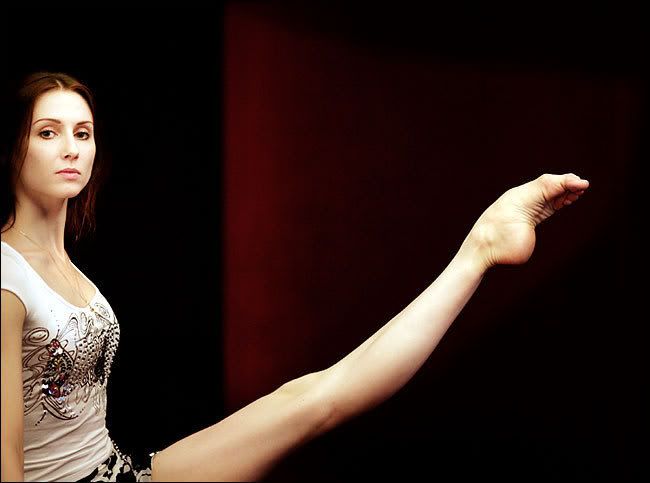 Recently I have been thinking a LOT about turnout- who doesn't? Everyone wants better turnout, every teacher is always reminding me about turnout- especially while I'm jumping. This week as I was replacing a hip, I got to thinking about turnout. During the surgical approach for a hip replacement we take off several muscles called the short external rotators- the gemelli, obturators, and piriformis muscles (picture of these muscles during surgery below). These muscles start in your pelvis and attach to the greater trochanter, which is that part of your hip bone that you can feel - unless you have some love handles like me! These muscles plus a part of the gluteus muscles, are was give you dynamic tunrout- turnout that you can change. I was detaching these on a lady and thinking- "Thank God I don't need a hip replacement or my turnout would be terrible." I know, its a ridiculous thought. But it got me thinking what else is responsible for my turnout and why are my develope's so much higher when I am turned in?
Recently I have been thinking a LOT about turnout- who doesn't? Everyone wants better turnout, every teacher is always reminding me about turnout- especially while I'm jumping. This week as I was replacing a hip, I got to thinking about turnout. During the surgical approach for a hip replacement we take off several muscles called the short external rotators- the gemelli, obturators, and piriformis muscles (picture of these muscles during surgery below). These muscles start in your pelvis and attach to the greater trochanter, which is that part of your hip bone that you can feel - unless you have some love handles like me! These muscles plus a part of the gluteus muscles, are was give you dynamic tunrout- turnout that you can change. I was detaching these on a lady and thinking- "Thank God I don't need a hip replacement or my turnout would be terrible." I know, its a ridiculous thought. But it got me thinking what else is responsible for my turnout and why are my develope's so much higher when I am turned in? Part of the the answer is the hip flexor anatomy. Hip flexion comes from the psoas muscle, the rectus femoris, and the sartorious. The psoas comes from the pelvis and attaches to inside of the hip- its a HUGE muscles that makes up the tendorloin cut of meat in animals. The rectus femoris also comes from the pelvis but attaches to your knee cap- allowing you to flex your hip and extend your leg but doesn't give you any turnout. The rectus is also a big muscle that you can feel and even see in some people. Hip flexion is also aided be the sartorius muscle. Called the tailor's muscle the sartorius starts up by the pelvis and crosess the knee- making it one of the few muscles that cross 2 joints. This is a really puny muscle but it attaches to the INSIDE/FRONT of the knee so it both extends the knee and "presents the heel" in the extended position.
Part of the the answer is the hip flexor anatomy. Hip flexion comes from the psoas muscle, the rectus femoris, and the sartorious. The psoas comes from the pelvis and attaches to inside of the hip- its a HUGE muscles that makes up the tendorloin cut of meat in animals. The rectus femoris also comes from the pelvis but attaches to your knee cap- allowing you to flex your hip and extend your leg but doesn't give you any turnout. The rectus is also a big muscle that you can feel and even see in some people. Hip flexion is also aided be the sartorius muscle. Called the tailor's muscle the sartorius starts up by the pelvis and crosess the knee- making it one of the few muscles that cross 2 joints. This is a really puny muscle but it attaches to the INSIDE/FRONT of the knee so it both extends the knee and "presents the heel" in the extended position.Some of everyone's turnout also comes from the specific bony anatomy of the hip- called anteversion. Anteversion of the hip gives you natural turnout and was a really difficult concept for me to grasp but suffice to day that you can't change it. As an adult, what ever anterversion you have is what you are going to have unless some surgeon cuts your bone and rotates it. We can change it a little in kids by having them sit "indian style" and avoiding "W" sitting and even then the anterversion only changes slightly. But if you started ballet as an adult your anteversion is fixed.
So pretty much ALL of my turnout comes from the short external rotators and the sartorius- all which are really tiny. When you are turned out in extension, the tiny rotators and puny sartorius externally rotate the hip and place my already tight hamstrings on even more stretch. Then they have to fight my big hamstring muscles to get my leg up in that nice turned out position. When I am turned in, the hamstings are looser and the psoas and rectus have an easier time of things.
 Thinking about this made me feel better about my terrible turnout and even more in awe of people who can do this...
Thinking about this made me feel better about my terrible turnout and even more in awe of people who can do this...
No comments:
Post a Comment